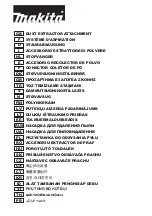
8
7.0
Set-Up and Assembly
7.1
Hole center dimensions
Figure 2
7.2
Unpacking
Open shipping container and check for shipping
damage. Report any damage immediately to your
distributor and shipping agent. Do not discard any
shipping material until the Shear is assembled and
running properly.
Compare the contents of your container with the
following list to make sure all parts are intact.
Missing parts, if any, should be reported to your
distributor. Read the instruction manual thoroughly
for assembly, maintenance and safety instructions.
Contents of the Shipping Container
1
Pneumatic Shear with Foot Pedal
2
Front Arm Extensions
1
Front Stop, with hardware
1
Rear Stop, with hardware
2 Scale
Rods
2
Adjusting Block Assemblies
1
Bevel Gauge, with hardware
1
Instructions and Parts Manual
1 Warranty
Card
1. Remove the crating material from around the
machine.
2. Clean the protectant from all exposed metal
surfaces with a mild solvent or kerosene, and
a soft rag. Do not use lacquer thinner, paint
thinner, or gasoline, as these may damage
painted surfaces.
3. Coat all machined surfaces with a light coat of
oil to inhibit rust.
4. Remove the bolts holding the machine to the
skid.
5. Place straps below the table (you may have to
remove front cover), and use propery rated
lifting equipment to move the machine to a
level foundation. Machine location must allow
access to all sides. Use shims at floor if
needed.
Assembly Note:
Prior to shipment, the pneumatic
shear is adjusted at the factory for proper
alignments and operation. If the machine does not
operate properly or the stand does not sit squarely
on the floor, proceed to
Set-Up
Adjustments
.
6. When the machine sits evenly, secure it to the
floor using proper fasteners. Refer to Figure 2.
7.3
Stop assemblies
Refer to Figure 1. (Numbers in parentheses refer to
corresponding part in exploded view.)
1. Attach the two
front arm extensions
(6) to the
bed with four
hex cap screws
(7) and four
washers
(76). Level arm extension surfaces
with the table before tightening.
2. Attach
front stop
(71) to front arm extensions
with T-screws (72) and wing nuts (74).
3. Attach
rear stop
(59) to the
adjusting block
assemblies (61) with six hex cap screws (68)
and six flat washers (77).
4. Insert
a
scale rod
(58) through each adjusting
block assembly and into cutter bar. The scales
must face up.
5. Secure the
scale rods
in the cutter bar by
tightening the two hex cap screws (40).
Tighten the rods in the adjusting blocks with
the four knobs (65).


































